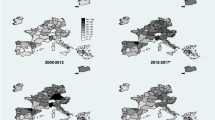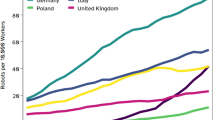Abstract
The debate about the impact of robots on employment has been lively. In this paper, I examine the effect of robots on local labor demand in South Korea, one of the most technologically advanced countries in terms of robotics. Using the regional variation in robot exposure constructed from national industry-level robot adoption data and the initial distribution of industrial employment in cities, I find that robots did not reduce local labor demand. However, I estimate declines in labor demand in the manufacturing sector and routine jobs. An increase in one robot per 1000 workers in terms of exposure to robots is correlated with a decline in the job vacancy growth rate of 2.6%p in the manufacturing sector and of 2.5%p in routine jobs. No significant relationship is found between robot exposure and labor demand in the service sector or non-routine jobs.

Source: IFR





Similar content being viewed by others
Notes
South Korea consists of 17 provinces, and these are further divided into 228 cities.
The OLFSE does not cover establishments with fewer than five permanent employees, agriculture, forestry and fishing, households, and the public sector. The location information is only available at the province-level, not the city-level.
The 18 IFR industries are the following. Outside manufacturing, there are agriculture, mining, utilities, construction, research, and services. In the manufacturing sector, the IFR industries include food and beverages, textiles, paper and printing, plastics and chemicals, minerals, basic metals, metal products, metal and machinery, electronics, automotive, other vehicles (for example, shipbuilding and aerospace), and other manufacturing (including wood and furniture). Acemoglu and Restrepo (2020) use 19 IFR industries, and here, I aggregate “wood and furniture” and “other manufacturing.”
The automotive and electronic industry experienced an increase in robot exposure of 189.65 and 177.98 robots per 1000 workers between 2010 and 2019 in South Korea. (Please refer to Column 1 in Table 8.) This significant increase is due to the huge projects aimed at manufacturing batteries for hybrid and electric cars, as well as the rise in the production of semiconductors and displays.
The 2010 control variables could potentially be endogenous since they are measured at a time when robotization may have already been underway. Therefore, I check the robustness of the results by including 1995 industry shares and demographic characteristics as control variables, since 1995 was before robotics technology advanced significantly, and find qualitatively similar results.
The possible threat to the IV strategy is that there could be common shocks affecting the same industries in South Korea and Singapore, such as declining international demand or other technological changes, and these shocks could induce the same industries in two countries to adopt robots. In this case, the estimates may confound the impact of robots with these pre-existing industry characteristics. The result in Panel A of Table 9 shows that robot adoption in Singapore is not associated with industry characteristics in 2010, suggesting that these confounders are not responsible for the results.
The LZs are geographical units referring to aggregated regions characterized by intense economic interactions.
Additionally, I further disaggregate routine labor demand into manual and analytic task-intensive occupations and estimate the negative impacts for both routine-manual and routine-analytic occupations. When I split up the non-routine labor demand into several manual and analytic task-intensive occupations, none of the estimates are significant.
References
Acemoglu D, Restrepo P (2020) Robots and jobs: evidence from US labor markets. J Polit Econ 128(6):2188–2244
Adao R, Kolesár M, Morales E (2019) Shift-share designs: theory and inference. Q J Econ 134(4):1949–2010
Anelli M, Giuntella O, Stell L (2024) Robots, marriageable men, family, and fertility. J Hum Resour 59(2):443–469
Autor DH, Dorn D (2013) The growth of low-skill service jobs and the polarization of the US labor market. Am Econ Rev 103(5):1553–1597
Autor DH, Levy F, Murnane RJ (2003) The skill content of recent technological change: an empirical exploration. Q J Econ 118(4):1279–1333
Borusyak K, Hull P, Jaravel X (2022) Quasi-experimental shift-share research designs. Rev Econ Stud 89(1):181–213
Dauth W, Findeisen S, Suedekum J, Woessner N (2021) The adjustment of labor markets to robots. J Eur Econ Assoc 19(6):3104–3153
de Vries GJ, Gentile E, Miroudot S, Wacker KM (2020) The rise of robots and the fall of routine jobs. Labour Econ 66:101885
Faber M (2020) Robots and reshoring: evidence from Mexican labor markets. J Int Econ 127:103384
Forsythe E, Kahn LB, Lange F, Wiczer D (2020) Labor demand in the time of COVID-19: evidence from vacancy postings and UI claims. J Public Econ 189:104238
Gihleb R, Giuntella O, Stella L, Wang T (2022) Industrial robots, workers’ safety, and health. Labour Econ 78:102205
Goldsmith-Pinkham P, Sorkin I, Swift H (2020) Bartik instruments: what, when, why, and how. Am Econ Rev 110(8):2586–2624
Goos M, Manning A, Salomons A (2014) Explaining job polarization: routine-biased technological change and offshoring. Am Econ Rev 104(8):2509–2526
Graetz G, Michaels G (2018) Robots at work. Rev Econ Stat 100(5):753–768
Gunadi C, Ryu H (2021) Does the rise of robotic technology make people healthier? Health Econ 30(9):2047–2062
Hershbein B, Kahn LB (2018) Do recessions accelerate routine-biased technological change? Evidence from vacancy postings. Am Econ Rev 108(7):1737–1772
Javorcik B, Stapleton K, Kett B, O’Kane L (2020) Unravelling deep integration: local labour market effects of the Brexit vote. CEPR discussion paper 14222
Koch M, Manuylov I, Smolka M (2021) Robots and firms. Econ J 131(638):2553–2584
Author information
Authors and Affiliations
Corresponding author
Ethics declarations
Conflict of interest
The author did not receive support from any organization for the submitted work and has no competing interests to declare that are relevant to the content of this article.
Additional information
Publisher's Note
Springer Nature remains neutral with regard to jurisdictional claims in published maps and institutional affiliations.
Rights and permissions
Springer Nature or its licensor (e.g. a society or other partner) holds exclusive rights to this article under a publishing agreement with the author(s) or other rightsholder(s); author self-archiving of the accepted manuscript version of this article is solely governed by the terms of such publishing agreement and applicable law.
About this article
Cite this article
Kim, H. The impact of robots on labor demand: evidence from job vacancy data in South Korea. Empir Econ (2024). https://doi.org/10.1007/s00181-024-02585-0
Received:
Accepted:
Published:
DOI: https://doi.org/10.1007/s00181-024-02585-0





